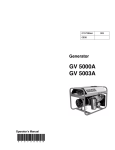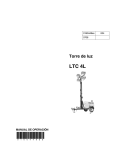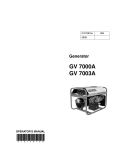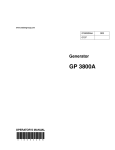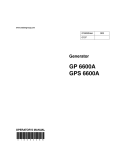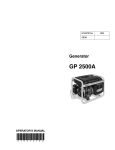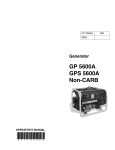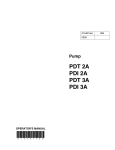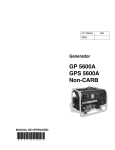Download Wacker Neuson G 3.3A Operator`s manual
Transcript
www.wackergroup.com 0154607en 0403 Generator G 3.3AE OPERATOR’S MANUAL 0 1 5 4 6 0 7 E N 004 wam DANGER CARBON MONOXIDE Using a generator indoors CAN KILL YOU IN MINUTES. Generator exhaust contains carbon monoxide (CO). This is a poison you cannot see or smell. If you can smell the generator exhaust, you are breathing CO. But even if you cannot smell the exhaust, you could be breathing CO. • NEVER use a generator inside homes, garages, crawlspaces, or other partly enclosed areas. Deadly levels of carbon monoxide can build up in these areas. Using a fan or opening windows and doors does NOT supply enough fresh air. • ONLY use a generator outside and far away from windows, doors, and vents. These openings can pull in generator exhaust. Even when you use a generator correctly, CO may leak into the home. ALWAYS use a battery-powered or battery-backup CO alarm in the home. If you start to feel sick, dizzy, or weak after the generator has been running, move to fresh air RIGHT AWAY. See a doctor. You could have carbon monoxide poison. G 3.3AE Table of Contents 1. Foreword 3 2. Safety Information 4 3. 4. 2.1 Laws Pertaining to Spark Arresters ...................................................... 4 2.2 Operating Safety .................................................................................. 5 2.3 Operator Safety while using Internal Combustion Engines .................. 6 2.4 Service Safety ...................................................................................... 7 2.5 Label Locations .................................................................................... 8 2.6 Safety and Operating Labels ................................................................ 9 Technical Data 13 3.1 Generator ........................................................................................... 13 3.2 Engine ................................................................................................ 14 3.3 Sound Specifications .......................................................................... 14 Operation 15 4.1 Application and Power Requirements ................................................ 15 4.2 Indoor Installation ............................................................................... 16 4.3 Outdoor Installation ............................................................................ 16 4.4 Grounding the Generator ................................................................... 17 4.5 Generator Derating ............................................................................. 18 4.6 Use of Extension Cords ...................................................................... 19 4.7 Earth-leakage Circuit Breaker ............................................................ 20 4.8 Control Panel ...................................................................................... 21 4.9 Before Starting ................................................................................... 22 4.10 To Run ................................................................................................ 23 4.11 To Stop ............................................................................................... 23 wc_bo0154607enTOC.fm 1 Table of Contents 5. G 3.3AE Maintenance 5.1 5.2 5.3 5.4 5.5 5.6 5.7 5.8 5.9 5.10 5.11 5.12 24 Engine Maintenance ............................................................................24 Periodic Maintenance Schedule ..........................................................24 Engine Oil ............................................................................................25 Air Cleaner ..........................................................................................26 Spark Plug ...........................................................................................27 Cleaning the Sediment Cup ................................................................28 Carburetor Adjustment ........................................................................28 Engine Speed ......................................................................................29 Storage ................................................................................................30 Transport .............................................................................................30 Troubleshooting ...................................................................................31 Wiring Schematic ...............................................................................32 wc_bo0154607enTOC.fm 2 Foreword 1. Foreword This manual provides information and procedures to safely operate and maintain this Wacker model. For your own safety and protection from injury, carefully read, understand and observe the safety instructions described in this manual. Keep this manual or a copy of it with the machine. If you lose this manual or need an additional copy, please contact Wacker Corporation. This machine is built with user safety in mind; however, it can present hazards if improperly operated and serviced. Follow operating instructions carefully! If you have questions about operating or servicing this equipment, please contact Wacker Corporation. The information contained in this manual was based on machines in production at the time of publication. Wacker Corporation reserves the right to change any portion of this information without notice. All rights, especially copying and distribution rights, are reserved. Copyright 2003 by Wacker Corporation. No part of this publication may be reproduced in any form or by any means, electronic or mechanical, including photocopying, without express written permission from Wacker Corporation. Any type of reproduction or distribution not authorized by Wacker Corporation represents an infringement of valid copyrights and will be prosecuted. We expressly reserve the right to make technical modifications, even without due notice, which aim at improving our machines or their safety standards. wc_si000053gb.fm 3 Safety Information 2. G 3.3A Safety Information This manual contains DANGER, WARNING, CAUTION, and NOTE callouts which must be followed to reduce the possibility of personal injury, damage to the equipment, or improper service. This is the safety alert symbol. It is used to alert you to potential personal injury hazards. Obey all safety messages that follow this symbol to avoid possible injury or death. DANGER indicates an imminently hazardous situation which, if not avoided, will result in death or serious injury. DANGER WARNING indicates a potentially hazardous situation which, if not avoided, could result in death or serious injury. WARNING CAUTION indicates a potentially hazardous situation which, if not avoided, may result in minor or moderate injury. CAUTION CAUTION: Used without the safety alert symbol, CAUTION indicates a potentially hazardous situation which, if not avoided, may result in property damage. Note: Contains additional information important to a procedure. 2.1 Laws Pertaining to Spark Arresters Notice: State Health Safety Codes and Public Resources Codes specify that in certain locations spark arresters be used on internal combustion engines that use hydrocarbon fuels. A spark arrester is a device designed to prevent accidental discharge of sparks or flames from the engine exhaust. Spark arresters are qualified and rated by the United States Forest Service for this purpose. In order to comply with local laws regarding spark arresters, consult the engine distributor or the local Health and Safety Administrator. wc_si000053gb.fm 4 G 3.3A 2.2 Safety Information Operating Safety BACKFEED FROM THE GENERATOR INTO THE PUBLIC POWER DISTRIBUTION SYSTEM CAN CAUSE SERIOUS INJURY OR DEATH TO UTILITY WORKERS! DANGER Improper connection of generator to a building's electrical system can allow electrical current from the generator to backfeed into utility lines. This may result in electrocution of utility workers, fire, or explosion. Connections to a building's electrical system must be made by a qualified electrician and comply with all applicable laws and electrical codes. If connected to a building's electrical system the generator must meet the power, voltage, and frequency requirements of the equipment in the building. Differences in power, voltage, and frequency requirements may exist and improper connection may lead to equipment damage, fire, and personal injury or death. Familiarity and proper training are required for the safe operation of equipment! Equipment operated improperly or by untrained personnel can be dangerous! Read the operating instructions contained in both WARNING this manual and the engine manual and familiarize yourself with the location and proper use of all controls. Inexperienced operators should receive instruction from someone familiar with the equipment before being allowed to operate the machine. wc_si000053gb.fm 2.2.1 NEVER operate generator when open containers of fuel, paint, or other flammable liquids are near. 2.2.2 NEVER operate generator, or tools attached to the generator, with wet hands. 2.2.3 NEVER use worn electrical cords. Severe electrical shock and equipment damage may result. 2.2.4 NEVER run electrical cords under the generator, or over vibrating or hot parts. 2.2.5 NEVER enclose or cover generator when in use or when hot. 2.2.6 NEVER overload generator. The total amperage of the tools and equipment attached to the generator must not exceed the load rating of the generator. 2.2.7 NEVER operate machine in snow, rain, or standing water. 2.2.8 NEVER allow untrained personnel to operate or service the generator. The generator set should be set up by a trained electrician. 2.2.9 ALWAYS store equipment properly when it is not being used. Equipment should be stored in a clean, dry location out of the reach of children. 2.2.10 ALWAYS be sure machine is on a firm, level surface and will not tip, roll, slide, or fall while operating. 5 Safety Information 2.3 2.2.11 ALWAYS transport generator in an upright position. 2.2.12 ALWAYS keep machine at least one meter (three feet) away from structures, buildings and other equipment during use. 2.2.13 ALWAYS keep the area immediately surrounding the generator clean, neat and free of debris. Make sure that the area overhead is clear of debris that could fall onto or into the generator, or exhaust compartment. 2.2.14 ALWAYS remove all tools, cords, and other loose items from generator before starting it. 2.2.15 ALWAYS make certain machine is well-grounded and securely fastened to a good earthen ground per national and local regulations. Operator Safety while using Internal Combustion Engines DANGER wc_si000053gb.fm G 3.3A Internal combustion engines present special hazards during operation and fueling! Read and follow warning instructions in engine owner's manual and safety guidelines below. Failure to follow warnings and safety guidelines could result in severe injury or death. 2.3.1 DO NOT run machine indoors or in an enclosed area such as a deep trench unless adequate ventilation, through such items as exhaust fans or hoses, is provided. Exhaust gas from the engine contains poisonous carbon monoxide gas; exposure to carbon monoxide can cause loss of consciousness and may lead to death. 2.3.2 DO NOT smoke while operating machine. 2.3.3 DO NOT smoke when refueling engine. 2.3.4 DO NOT refuel hot or running engine. 2.3.5 DO NOT refuel engine near open flame. 2.3.6 DO NOT spill fuel when refueling engine. 2.3.7 DO NOT run engine near open flames. 2.3.8 DO NOT start engine if fuel has spilled or an odor of fuel is present. Move generator away from the spill and wipe generator dry before starting. 2.3.9 ALWAYS refill fuel tank in well-ventilated area. 2.3.10 ALWAYS replace fuel tank cap after refueling. 2.3.11 ALWAYS check fuel lines and fuel tank for leaks and cracks before starting engine. Do not run machine if fuel leaks are present or fuel lines are loose. 6 G 3.3A 2.4 Safety Information Service Safety WARNING wc_si000053gb.fm Poorly maintained equipment can become a safety hazard! In order for the equipment to operate safely and properly over a long period of time, periodic maintenance and occasional repairs are necessary. If the generator is experiencing problems or is being serviced, attach a "DO NOT START" sign to the control panel to notify other people of its condition. 2.4.1 DO NOT use gasoline or other types of fuels or flammable solvents to clean parts, especially in enclosed areas. Fumes from fuels and solvents can become explosive. 2.4.2 DO NOT attempt to clean or service machine while it is running. 2.4.3 DO NOT modify the equipment without express written approval of the manufacturer. 2.4.4 DO NOT allow water to accumulate around the base of the machine. If water is present, move the machine and allow it to dry before servicing. 2.4.5 DO NOT service machine if clothing or skin is wet. 2.4.6 DO NOT allow untrained personnel to service this equipment. Only trained electrical technicians should be allowed to service the electrical components of this equipment. 2.4.7 ALWAYS keep machine clean and labels legible. Replace all missing and hard-to-read labels. Labels provide important operating instructions and warn of dangers and hazards. 2.4.8 ALWAYS replace safety devices and guards after repairs and maintenance. 2.4.9 ALWAYS let engine cool before transporting or servicing. 2.4.10 ALWAYS keep hands, feet, and loose clothing away from moving parts on generator and engine. 2.4.11 ALWAYS turn engine off before servicing generator. If the engine has electric start, disconnect negative terminal on battery 2.4.12 ALWAYS keep fuel lines in good condition and properly connected. Leaking fuel and fumes are extremely explosive. 7 Safety Information 2.5 G 3.3A Label Locations D A N G E R G E F A H R P E L IG R O S T O P 2 - 1 5 1 1 5 6 GND 88897 D A N G E R wc_gr000675 wc_si000053gb.fm 8 G 3.3A 2.6 Safety Information Safety and Operating Labels Wacker machines use international pictorial labels where needed. These labels are described below: Label Meaning D A N G E R G E F A H R P E L IG R O S T O P D A N G E R DANGER! Engines emit carbon monoxide; operate only in well ventilated area. Read the operator's manual. No sparks, flames or burning objects near machine. Shut off engine before refueling. DANGER! Electric shock hazard. Read operator’s manual for instructions. WARNING! Hot surface. CAUTION! Read and understand the supplied operator's manual before operating this machine. Failure to do so increases the risk of injury to yourself or others. CAUTION! Lifting point GND wc_si000053gb.fm 88897 Electrical ground. 9 Safety Information G 3.3A Label Meaning 1 2 5 3 6 1 4 3 2 Open main circuit breaker. Open fuel flow valve. Close choke. Push or turn engine switch to ON position. Pull rewind starter. Press engine crank switch to "CRANK" position. Open choke. wc_si000053gb.fm 10 G 3.3A Safety Information Label Meaning Close main circuit breaker. Push or turn engine switch to OFF position. Press engine crank switch to "OFF" position. Close fuel flow valve. 2 - 1 5 1 1 5 6 Potential Earth - Hook up cable from grounding rod to this point. Guaranteed sound power level in dB(A). wc_si000053gb.fm 11 Safety Information G 3.3A Label Meaning MENOMONEE FALLS, WI USA 53051 Model Rev. Serial No. hz lbs kW class V N/M A GENERATING SET ISO 8528 MADE IN USA Insul. Class Man. Yr. 110635 Item No. kg A nameplate listing the Model Number, Item Number, Revision, and Serial Number is attached to each unit. Please record the information found on this plate so it will be available should the nameplate become lost or damaged. When ordering parts or requesting service information, you will always be asked to specify the model, item number, revision number, and serial number of the unit. This machine may be covered by one or more patents. wc_si000053gb.fm 12 G 3.3A 3. Technical Data Technical Data 3.1 Generator Item No. G3.3AE 0008259 Generator Output Type AC Voltages Available Frequency Power Factor AC receptacles 3.3 kVA Single voltage, single phase, brush-type system 230 / 1ø volts / phase Hz 50 cos Ø 1.0 2 / 16 qty / amp Main Circuit Breaker amp 15 Dimensions mm 685 x 585 x 530 Weight (dry) Kg 71 wc_td000056gb.fm 13 Technical Data 3.2 G 3.3A Engine Item No. G3.3AE 0008259 Engine Engine Make Honda Engine Model GX 240 K1 QA2 Rated Power 4.8 kW Spark Plug NGK BPR 6ES Electrode Gap mm 0.7 - 0.8 Engine Speed - full load rpm 3000 ± 100 Engine Speed - no load rpm 3100 ± 100 Air Cleaner type Dual element Engine Lubrication oil grade Engine Oil Capacity SAE 10W30 service class SG or SF 1100 ml Fuel type Regular unleaded gasoline Fuel Tank Capacity liters 19.5 liters/hr. 2.38 Fuel Consumption Running Time hrs. 8.2 Valve clearance (cold) mm Inlet: 0.15 Outlet: 0.20 3.3 Sound Specifications The required sound specification, Paragraph 1.7.4.f of 89/392/EEC Machinery Directive, is: Guaranteed sound power level (LWA) = 99 dB(A). This sound value were determined according to ISO 3744 for the sound power level (LWA). wc_td000056gb.fm 14 G 3.3A 4. Operation Operation 4.1 Application and Power Requirements This generator is designed to operate single-phase, 50 Hz appliances running at 230 VAC. CAUTION: Do not exceed the power output of the generator. Damage to tools or generator will occur. See Technical Data. Check the nameplate or label provided on tools and appliances to make sure their power requirements are met by the power output of the generator. If the wattage is not given for a particular tool or appliance, contact the tool manufacturer for wattage requirements. Some appliances and tools require a surge of current when starting. This means that the amount of power needed to initially start the equipment is larger than the power required to keep it running. The generator must be capable of supplying this "surge" current. Other types of appliances require more power than is actually stated on their nameplate. The information in “Approximate Starting Power Requirements” is offered only as a general guideline to help you determine power requirements for different types of equipment. Check with your nearest Wacker dealer, or contact the manufacturer or dealer of the tool or appliance, if you have questions regarding power requirements. CAUTION: DO NOT exceed the rated current limit of any receptacle. CAUTION: If a tool or appliance does not reach full speed within a few seconds after it is switched on, turn it off immediately to avoid damage. Approximate Starting Power Requirements • Incandescent lights and appliances such as irons and hot plates, which use a resistive-type heating element, require the same wattage to start and run as is stated on their nameplates. • Fluorescent and mercury lamps require 1.2–2 times their stated wattage to start. • Electrical motors and many types of electrical tools often require a large starting current. The amount of starting current depends on the type of motor and its use. • Most electrical tools require 1.2–3 times their stated wattage for starting. • Loads such as submersible pumps and air compressors require a very large force to start. They need as much as 3–5 times the wattage stated on the nameplate in order to start. If the wattage is not given for a particular tool or appliance, it can be calculated by multiplying its voltage and amperage requirements: VOLTS x AMPS = WATTS wc_tx000150gb.fm 15 Operation 4.2 Indoor Installation DANGER 4.3 G 3.3A If the generator must be installed indoors, adequate ventilation or exhaust hoses must be provided. When venting exhaust fumes, make sure the exhaust piping is large enough to prevent excessive back pressure to the engine. Back pressure reduces engine efficiency and may cause the engine to overheat. Exhaust gas from the engine contains poisonous carbon monoxide gas; exposure to carbon monoxide can cause loss of consciousness and may lead to death. Never run generator indoors or in an enclosed area unless adequate ventilation, through such items as exhaust hoses or fans, is provided. When installed indoors, steps to prevent fire and explosion such as providing a good earthen ground, removing all flammable materials near generator, and using only electrical cables in good condition, must be observed. See Operating Safety. Outdoor Installation Place the generator in an area where it will not be exposed to rain, snow or direct sunlight. Make sure it is positioned on firm, level ground so it will not slide or shift. Position engine exhaust away from areas where people may be present. If operating the generator inside a tunnel or deep trench, make sure there is adequate ventilation. Precautions similar to those required when operating indoors may be necessary. The surrounding area must be free from water and moisture. All components must be protected from excessive moisture. wc_tx000150gb.fm 16 G 3.3A 4.4 Operation Grounding the Generator See Graphic: wc_gr000544 The generator should be grounded to a good ground source in compliance with state and local regulations. Use 10 mm2 wire and secure one end to the ground terminal (a) provided on the generator frame and the other end to a suitable ground source. = w c _ g r0 0 0 5 4 4 wc_tx000150gb.fm 17 Operation 4.5 G 3.3A Generator Derating All generators are subject to derating for altitude and temperature. Internal combustion engines, unless modified, run less efficiently at higher altitudes due to the lack of air pressure. This translates into a lack of power and thus reduction in generator output. Temperature affects both engine and generator performance. As temperature increases, an engine will run less efficiently and the more resistance will be found in electrical components. Therefore, as the temperature increases, the output of the generator decreases. Altitude also affects the cooling capacity of air—the higher the altitude the less dense the air is and thus the lower its ability to transfer heat. For every increase in altitude of 500 m (1650 ft.) above 1000 m (3300 ft.), the output of the generator will be reduced by 3%. For every increase of 5° C (9° F) in ambient temperature above 40° C (104° F), the output of the generator will be reduced by 3%. Use the tables shown for altitude and temperature deration factors. It may be necessary to consider both altitude and ambient temperature deration factors to determine true generator output. wc_tx000150gb.fm Ambient Temp. °C (°F) Derate Factor 45 (113) 3% 0.97 50 (122) 6% 0.94 55 (131) 9% 0.91 60 (140) 12 % 0.88 Altitude m (ft.) Derate Factor 1500 (4900) 3% 0.97 2000 (6600) 6% 0.94 2500 (8200) 9% 0.91 3000 (9900) 12 % 0.88 3500 (11500) 15 % 0.85 4000 (13100) 18 % 0.82 18 G 3.3A Operation 4.6 Use of Extension Cords WARNING When a long extension cord is used to connect an appliance or tool to the generator, a voltage loss occurs—the longer the cord, the greater the voltage loss. This results in less voltage being supplied to the appliance or tool and increases the amount of current draw or reduces performance. A cord with a larger cross section will reduce the voltage loss. CAUTION: Operating equipment at low voltage can cause it to overheat. Use the table as a guide for selecting proper cable size. Use only tough rubber-sheathed cable in accordance with IEC 245-4. Damaged cords can cause electrical shock. Electric shock can cause serious injury or death. DO NOT use worn, bare, or frayed cords. Replace damaged cords immediately. Minimum Extension Cord Size 230V Volts 230 V Amp Rating wc_tx000150gb.fm Total length of cord in meters 0 - 30 30 - 60 Cross sectional area of wire in mm2 2 0.75 1.5 4 1.5 2.5 6 1.5 4 8 2.5 4 10 2.5 6 15 4 10 20 6 10 25 6 16 30 10 16 19 Operation 4.7 G 3.3A Earth-leakage Circuit Breaker See Graphic: wc_gr000661 Generator models ending with an “AE” are equipped with an earthleakage circuit breaker. The circuit breaker is current-operated and shuts off the power to the receptacles when a ground fault of 30 milliAmps or greater occurs in the generator or to a piece of equipment attached to the generator. The circuit breaker is located on the control panel and should be tested for proper operation every time the generator is used. To test the earth-leakage circuit breaker: 4.7.1 Start the generator. 4.7.2 Place main circuit breaker in closed position. 4.7.3 Push the TEST button (a) on the circuit breaker. The circuit breaker lever will lower to the open position (b2). Power is now off at both receptacles. If the lever does not lower, the circuit breaker is not working. Do not use the generator until the problem can be corrected. 4.7.4 To restore power to the receptacles, raise the circuit breaker lever to the closed position (b1). If the circuit breaker lever lowers to the open position during operation, stop the generator and check it and equipment for defects. Repair all defects before operating generator. b1 a a b2 wc_gr000661 wc_tx000150gb.fm 20 G 3.3A 4.8 Operation Control Panel See Graphic: wc_gr000679 The generator is protected by a 15 amp circuit breaker (a) located on the control panel. The circuit breaker protects the generator from severe overloads or short circuits. If the circuit breaker opens, turn the engine off immediately and determine the cause before restarting. Check the appliances and tools attached to the generator for defects and make sure their power requirements do not exceed the power rating of the generator or the current limit of the receptacles. When the circuit breaker opens, the breaker lever will snap down. To reset circuit breaker, lift lever up. 1 2 5 3 6 1 3 4 2 a b T E S T c wc_gr000679 Control Panel Ref. Description a Main circuit breaker - 15 amps b Receptacles wc_tx000150gb.fm Ref. c 21 Description Earth-leakage circuit breaker (models “AE” only) Operation 4.9 wc_tx000150gb.fm G 3.3A Before Starting 4.9.1 Read and understand safety and operating instructions at beginning of this manual. 4.9.2 Read and understand the meanings of all warning and operating labels. 4.9.3 Check: • oil level in engine. • fuel level. • condition of air cleaner. • tightness of external fasteners. • condition of fuel lines. 22 G 3.3A Operation 4.10 To Run See Graphic: wc_gr000679 and wc_gr000665 4.10.1 Disconnect all loads from the generator and place main circuit breaker lever in open position (O). 4.10.2 Open fuel valve by moving lever to the right (a1). 4.10.3 If engine is cold, move choke lever to closed position (b1). If engine is hot, set choke to open position (b2). 4.10.4 Turn engine switch to "ON" (c1) and pull starter rope (d). Note: If the oil level in the engine is low, the engine will not start. If this happens, check oil level and add oil as needed. 4.10.5 Open choke as engine warms (b2). 4.10.6 Place main circuit breaker in closed position (l). Allow engine to warm up a few minutes before attaching loads. On models ending with an “AE” check the function of the earth-leakage circuit breaker. See Earth-leakage Circuit Breaker. c2 b2 a1 c1 b1 a2 d wc_gr000665 4.11 To Stop See Graphic: wc_gr000679 and wc_gr000665 4.11.1 Turn off and disconnect all tools and appliances attached to the generator. 4.11.2 Place main circuit breaker in open position (O). 4.11.3 Turn the engine switch to "OFF" (c2). 4.11.4 Close fuel valve by moving lever to the left (a2). Note: To stop engine quickly in an emergency, turn engine switch to "OFF". wc_tx000150gb.fm 23 Maintenance 5. G 3.3A Maintenance 5.1 Engine Maintenance The chart below lists basic machine and engine maintenance. Refer to engine manufacturer’s Operator’s Manual for additional information on engine maintenance. 5.2 Periodic Maintenance Schedule Daily before starting Check fuel level. • Check engine oil level. • Inspect air filter. Replace as needed. • Check and tighten external hardware. • After first 20 hrs. Clean air cleaner element.* Every 50 hrs. Every 100 hrs. Every 300 hrs. • Inspect shockmounts for damage. • Change engine oil.* • • Clean sediment cups. • Check and clean spark plug. • Check and adjust valve clearance. • Clean fuel tank.* • Check condition of fuel line. Replace when necessary. • *Service more frequently in dusty conditions. wc_tx000161gb.fm 24 G 3.3A 5.3 Maintenance Engine Oil See Graphic: wc_gr000022 5.3.1 Drain oil while the engine is still warm. 5.3.2 Remove the oil fill plug (a) and drain plug (b) to drain oil. Note: In the interests of environmental protection, place a plastic sheet and a container under the machine to collect any liquid which drains off. Dispose of this liquid in accordance with environmental protection legislation. wc_tx000161gb.fm 5.3.3 Install drain plug. 5.3.4 Fill the engine crankcase with recommended oil up to the level of the plug opening (c). See Technical Data for oil quantity and type. 5.3.5 Install the oil filler plug. 25 Maintenance 5.4 G 3.3A Air Cleaner See Graphic: wc_gr000025 The engine is equipped with a dual element air cleaner. Service air cleaner frequently to prevent carburetor malfunction. CAUTION: NEVER run engine without air cleaner. Severe engine damage will occur. NEVER use gasoline or other types of low flash point solvents for cleaning the air cleaner. A fire or explosion could result. WARNING To service: wc_tx000161gb.fm 5.4.1 Remove air cleaner cover (a). Remove both elements and inspect them for holes or tears. Replace damaged elements. 5.4.2 Wash foam element (b) in solution of mild detergent and warm water. Rinse thoroughly in clean water. Allow element to dry thoroughly. Soak element in clean engine oil and squeeze out excess oil. 5.4.3 Tap paper element (c) lightly to remove excess dirt. Replace paper element if it appears heavily soiled. 26 G 3.3A 5.5 Maintenance Spark Plug See Graphic: wc_gr000028 Clean or replace spark plug as needed to ensure proper operation. Refer to the engine Owner’s Manual. The muffler becomes very hot during operation and remains hot for a while after stopping the engine. Do not touch the muffler while it is hot. WARNING Note: Refer to the Technical Data for the recommended spark plug type and the electrode gap setting. 5.5.1 Remove spark plug and inspect it. 5.5.2 Replace plug if the insulator is cracked or chipped. 5.5.3 Clean spark plug electrodes with a wire brush. 5.5.4 Set the electrode gap (a). 5.5.5 Tighten spark plug securely. CAUTION: A loose spark plug can become very hot and may cause engine damage. wc_tx000161gb.fm 27 Maintenance 5.6 G 3.3A Cleaning the Sediment Cup See Graphic: wc_gr000029 5.7 5.6.1 Turn fuel valve off. 5.6.2 Remove sediment cup (a) and O-ring (b). 5.6.3 Wash both thoroughly in a nonflammable solvent. Dry and reinstall them. 5.6.4 Turn fuel valve on and check for leaks. Carburetor Adjustment See Graphic: wc_gr001061 The pilot screw (a) is fitted with a limiter cap to prevent excessive enrichment of the air-fuel mixture in order to comply with emission regulations. The mixture is set at the factory and no adjustment should be necessary. Do not attempt to remove the limiter cap. The limiter cap cannot be removed without breaking the pilot screw. a wc_gr001061 wc_tx000161gb.fm 28 G 3.3A 5.8 Maintenance Engine Speed See Graphic: wc_gr000114 Adjust engine to the no load or idle speed per the Technical Data. 5.8.1 Start the engine and allow it to warm up to normal operating temperature. 5.8.2 Turn the throttle stop screw (a) in to increase speed, out to decrease speed. Make sure the throttle lever is touching the stop screw before measuring rpm. a wc_gr000114 wc_tx000161gb.fm 29 Maintenance 5.9 G 3.3A Storage Before storing generator for a long period of time: 5.9.1 Close the fuel valve and remove and empty sediment cup under carburetor. 5.9.2 Disconnect the fuel line from the carburetor. Place open end of fuel line into a suitable container and open fuel valve to drain fuel from tank. Gasoline is extremely flammable. Drain fuel tank in a well ventilated area. DO NOT drain tank in an area with flames or sparks. WARNING 5.9.3 Loosen the drain screw on the carburetor and drain any remaining fuel from carburetor. 5.9.4 Change the engine oil. 5.9.5 Remove the spark plug and pour approximately 30 ml (1 ounce) of clean engine oil into the cylinder. Crank the engine a few turns to distribute the oil to the inside of the cylinder walls. 5.9.6 Pull the starter rope slowly until resistance is felt and leave handle in this position. This ensures that the intake and exhaust valves are closed. 5.9.7 Store generator in a clean, dry area. 5.10 Transport Let the engine cool before transporting the generator or storing indoors, to avoid burns or fire hazards. WARNING When transporting the generator: wc_tx000161gb.fm 5.10.1 Turn the engine fuel valve to the OFF position. 5.10.2 Position the generator level to prevent fuel from spilling. 5.10.3 Secure the generator by tying it down with a suitable rope. 30 G 3.3A Maintenance 5.11 Troubleshooting Problem / Symptom Reason / Remedy If engine doesn't start, check that: • Engine switch is on "Start". • Fuel valves under fuel tank and on engine are open. • Fuel tank has fuel. • Choke lever is in correct position. Choke should be closed when starting a cold engine. • All loads are disconnected from generator. • Spark plug is in good condition. • Spark plug cap is tight. • Engine oil level is adequate. If engine starts but there is no power at receptacles, check that: • Circuit breaker is closed. If engine starts but runs erratically, check that: • Hose routing from the fuel tank to the engine is correct. For proper operation, the hose must run through the bushing in the lifting bracket. Refer to the Parts Book for illustration. • Connector from generator to control panel is tight. Wire Colors B Black R Red Y Yellow Or Orange G Green T Tan Br Brown Pr Purple L Blue V Violet Cl Clear Sh Shield P Pink W White Gr Gray LL Light Blue wc_tx000161gb.fm 31 Maintenance 5.12 G 3.3A Wiring Schematic See Graphic: wc_gr000680 Ref. Description A Generator Ref. Description Ref. Description Ref. B Control Box C Ref. Description Engine Description 1. Main stator winding 7. RFI suppressor 2. Main circuit breaker 8. Rotor winding 3. Earth-leakage circuit breaker (“AE” models only) 9. Automatic voltage regulator 4. 16A receptacle 10. Ignition switch 5. Choke 11. Oil level switch 6. Auxilliary winding 12. Coil A B 1 R 1 L1 L2 W 9 4 R 2 LL/W 2 R/W 1 3 3 7 LL/W Br 3 RB F2 Br F1 8 2 L 1 1 L/L LL/B 2 T 4 R/B LL/B 1 2 F2 F1 LL/Gr LL/B 4 R/B R/Gr R/B 4 G/Y G/Y G/Y G/Y G/Y 10 ON OFF C Z1 6 B Z2 Z1 5 Y G B/R B Z3 Z2 11 12 Z3 wc_gr000680 wc_tx000161gb.fm 32 EC DECLARATION OF CONFORMITY CE-KONFORMITÄTSERKLÄRUNG DECLARACIÓN DE CONFORMIDAD DE LA CE DÉCLARATION DE CONFORMITÉ C.E. WACKER CORPORATION, N92 W15000 ANTHONY AVENUE, MENOMONEE FALLS, WISCONSIN USA AUTHORIZED REPRESENTATIVE IN THE EUROPEAN UNION BEVOLLMÄCHTIGTER VERTRETER FÜR DIE EUROPÄISCHE GEMEINSCHAFT REPRESENTANTE AUTORIZADO EN LA UNIÓN EUROPEA REPRÉSENTANT AGRÉÉ AUPRÈS DE L’UNION EUROPÉENNE WACKER CONSTRUCTION EQUIPMENT AG Preußenstraße 41 80809 München hereby certifies that the construction equipment specified hereunder / bescheinigt, daß das Baugerät / certifica que la máquina de construcción / atteste que le matériel : 1. Category / Art / Categoría / Catégorie Power Generators Kraftstromerzeuger Grupos Electrógenos Groupe Électrogènes de Puissance 2. Type - Typ - Tipo - Type G3.3A, G3.3AE, G3.3AI 3. Item number of equipment / Artikelnummer / Número de referencia de la máquina / Numéro de référence du matériel : 0008251, 0008252, 0008253, 0008254, 0008255, 0008256, 0008257, 0008258, 0008259, 0009036 4. Electric power / Elektrische Leistung / Potencia eléctrica / Force motrice : 3,3 kW Has been sound tested per Directive 2000/14/EC / In Übereinstimmung mit Richtlinie 2000/14/EG bewertet worden ist / Ha sido ensayado en conformidad con la norma 2000/14/CE / A été mis à l’épreuve conforme aux dispositions de la directive 2000/14/CEE : Conformity Assessment Procedure / Konformitätsbewertungsverfahren / Procedimiento para ensayar conformidad / Procédé pour l’épreuve de conformité Name and address of notified body / Bei folgender einbezogener Prüfstelle / Oficina matriculadora / Organisme agrée Annex VIII / Anhang VIII Anexo VIII / Annexe VIII BSI, 389 Chiswick High Road, London W4 4AL United Kingdom Measured sound power level / Gemessener Schallleistungspegel / Nivel de potencia acústica determinado / Niveau de puissance acoustique fixé Guaranteed sound power level / Garantierter Schallleistungspegel / Nivel de potencia acústica garantizado / Niveau de puissance acoustique garanti 97 dB(A) 99 dB(A) and has been produced in accordance with the following standards: und in Übereinstimmung mit folgenden Richtlinien hergestellt worden ist: y ha sido fabricado en conformidad con las siguientes normas: et a été produit conforme aux dispositions des directives européennes ci-après : 2000/14/EC 89/336/EEC 98/37/EEC 09.04.03 Date / Datum / Fecha / Date 2003-CE-Generators33Q.fm William Lahner Vice President of Engineering Dan Domanski Manager, Product Engineering WACKER CORPORATION Wacker Construction Equipment AG · Preußenstraße 41 · D-80809 München · Tel.: +49-(0)89-354 02 - 0 · Fax: +49 - (0)89-354 02-390 Wacker Corporation · P.O. Box 9007 · Menomonee Falls, WI 53052-9007 · Tel. : +1-(1)(262) 255-0500 · Fax: +1-(1)(262) 255-0550 · Tel. : (800) 770-0957 Wacker Asia Pacific Operations · Sunley Center, Unit 912, 9/F · 9 Wing Qin Street, Kwai Chung, N.T. · Hong Kong · Tel. + 852 2406 60 32 · Fax: + 852 2406 60 21




































